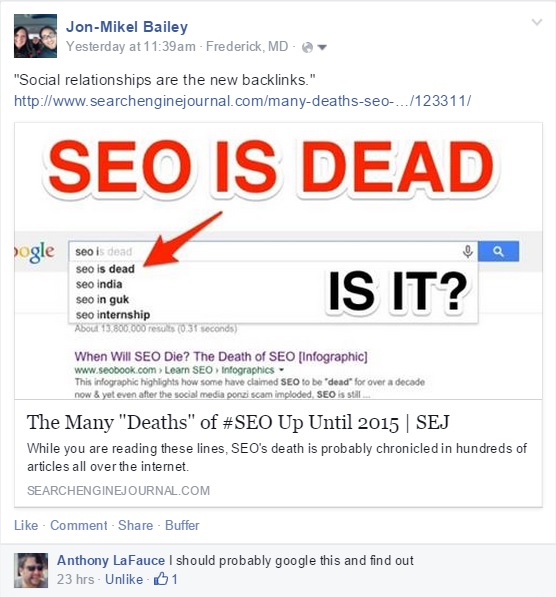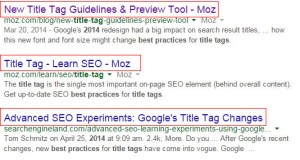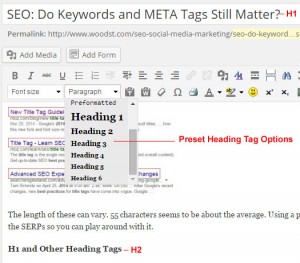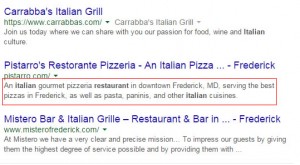The one constant with SEO (search engine optimization) is change. Search engines have been around since the 90s and have since died a thousand deaths.
I recently read a post about the many deaths of SEO (literally recounting all the times SEO has died). Great article, but I especially liked the comment I got when I posted it to Facebook…

I seriously doubt that SEO is going anywhere anytime soon. That said, SEO is very different from what is was 5, 10, 15 years ago.
In the early days of SEO, you could stuff your website with some keywords and META tags it would rank well. SEO is much more complex today. To help clear things up a bit, let’s split SEO up into two parts:
- Coding
- Context
Let’s start with Coding:
Coding
Tags Still Matter
Even though the META Keyword tags have been useless for a while now, some tags still play a big part in SEO. The good news is that now, with a CMS like WordPress, you can update these tags yourself.
Here are a few that still make a difference:
Title Tag
In older browsers, this was the text you would see along the top bar. Newer browsers usually do not show the title tag (because they now offer tabs), but it does still matters.
Each page should have a unique title tag that specifically describes the content within that page. You want to use keywords in your tag but make sure it makes sense to the reader. These tags signal to the engines what the page is about.
They will also show in the SERP (search engine results pages) listings…

The length of these can vary. 55 characters seems to be about the average. Using a plugin like Yoast will allow you to see how your titles will appear in the SERPs so you can play around with it.
H1 and Other Heading Tags
These tags are also important. The engines will look at these as indicators of context:
- What is this page about? H1
- What is this section about? H2, H3, H4
Using a CMS, your website developer can preset these for you:

The sample above is from WordPress. The title box is automatically set to be an H1. Then, you’ll want to use H2-H4 for headings within the content area.
Same rule applies here – use keywords but make sure it makes sense to the reader.
META Description Tag
This tag has no direct effect on your page ranking. However, it is still important. More often than not, this is the information that shows up in the SERPs as the page’s description.
This is your SERP sales pitch. Use this tag to describe the page in such a way that the user will want to click.
I did a search for Italian Restaurants in Google. Here are some of the results:

Personally, the Pistarro’s description makes me the hungriest.
Again, using a plugin like Yoast for WordPress, you can easily update and test your META descriptions. You have 150 characters worth of prime advertising space here. Use it wisely!
There are other coding updates you can make like ALT attributes for images or link titles. While these help the usability of the website, they really do nothing for SEO, so I’ll save them for another post.
If you want to get even more technical you can look at schema.org for markup and coding do’s and don’t’s.
Now, let’s talk about context…
Context
We’ve written extensively about the importance of context when it comes to SEO. It’s not just the content on the page that matters. It’s the relationship between that content and…
- Audience needs
- Related pages
- Links to and from the page
- Social and other shares
The Internet is just a bunch of data passing from here to there and so forth. What makes it so useful is the context of that data as it relates to a user’s needs.
Keywords in and of themselves serve no good purpose. It’s the context of those words and phrases that really make an impact. It’s now more about the long tail…
Long Tail Keywords
Keyword strategies have changed quite a bit in the past few years. Google, Bing and Yahoo are now rank sites based on context rather that just a list of words and phrases.
We wrote about “the long tail” back in 2009. So, this is nothing new. But, the long tail is getting a lot of traction lately.
Just think about the types of searches you perform on Google. How often do you search using just one or two words? And when you do, do you find you need to add additional words to the search to narrow down the results?
You might search for “Starbucks” but either you or Google will narrow this search as it relates to your location and your needs. For example:
- Brand name: Starbucks
- Location: Washington, DC
- Long tail descriptor: Drive-thru
Many people perform searches as questions. And think about OK Google and Siri. I’m sure you’ve seen the commercials where people are asking their phones questions. This is all part of SEO.
For the engines to compete, they can no longer offer up results based on the number of times a word or phrase appears in the content. Now, they have to understand the context of the search.
For you to succeed in any SEO efforts, you need to understand and optimize for long tail keyword phrases. Understanding your audience is step one. Know them and know what they want from you.
A typical long tail keyword might look something like this:
Keyword –> modifier –> modifier –> location
Google, and other engines, are smart enough now to find these words in various places in your content. So, you do not have to have the exact long tail phrase in your content over and over.
General rule of thumb is to write for your audience. Make the content readable, but also have a list of target long tail phrases handy as a reference and include them in your content.
Link Building
Link exchanges used to be the currency of SEO. People would talk about the “link juice.” Some folks even paid for link exchanges from services promising top ranking. They learned the hard way that there is no easy link building formula and their site was summarily penalized.
That said, links still matter. A quality link creates another channel through which users and engines can discover your content. But, what is a quality link?
You need to think about the source. If the source is a crappy website with thin and useless content, then the quality of the link back to your website is diminished. In many cases it can actually harm your ranking.
Link building starts with quality content. If you create great and useful content, or Utility Content, others will share and promote that content. This is called Inbound Content Marketing.
As you create great content and share it with your social networks, through your email newsletter, and on other websites, you build a steady stream of fans and eventually links.
These links and social signals are gold! They tell the engines as well as potential clients that you are a trusted authority. Here are some of the types of links you want:
- Social shares – encourage your fans and followers to share your posts (try posting 20% your content, 80% other useful content)
- Email newsletters that link back to your blog or website
- Listings in popular blogs with authority in your industry (these are no bought, they are earned!)
- Internal linking – link to services pages, promotions, and other posts as it make sense for the user.
Of course, anything that valuable takes hard work. Again, make sure you:
- Get to know your audience
- Create a content marketing plan
- Track your results
- Stick to that plan and adjust as needed
Code and Context Rule!
Taking these steps means your website and content are effective and evergreen. You’re building quality traffic over time that lasts.
The social shares and email marketing will help to prime the pump. The search engines will take a little longer to catch up and index your content. But stick with it.
And use your social channels and email newsletter as indicators of your content’s quality:
- If you post something that takes off, try more of that type of post.
- If you post something and get crickets, kill it or reimagine it.
SEO is not a quick fix solution. And it’s not going anywhere. Do the work and you will see the results!
(297)







